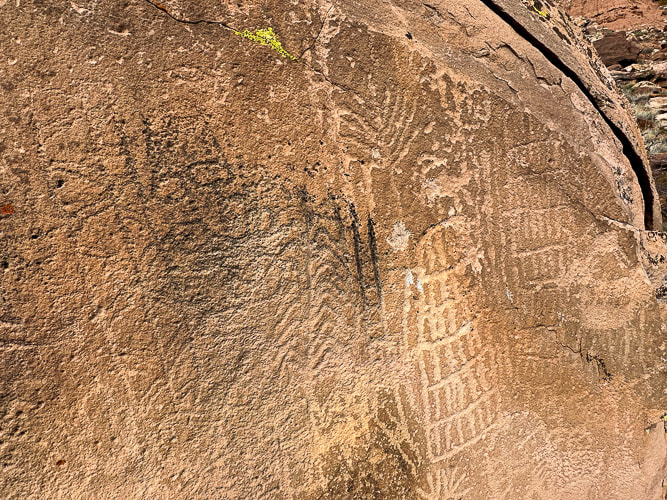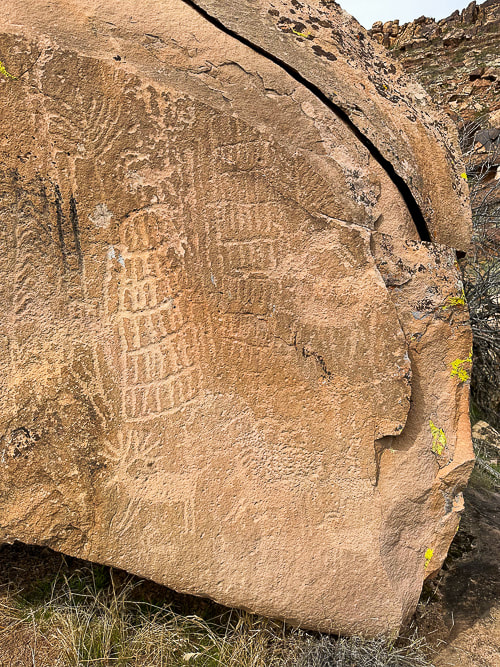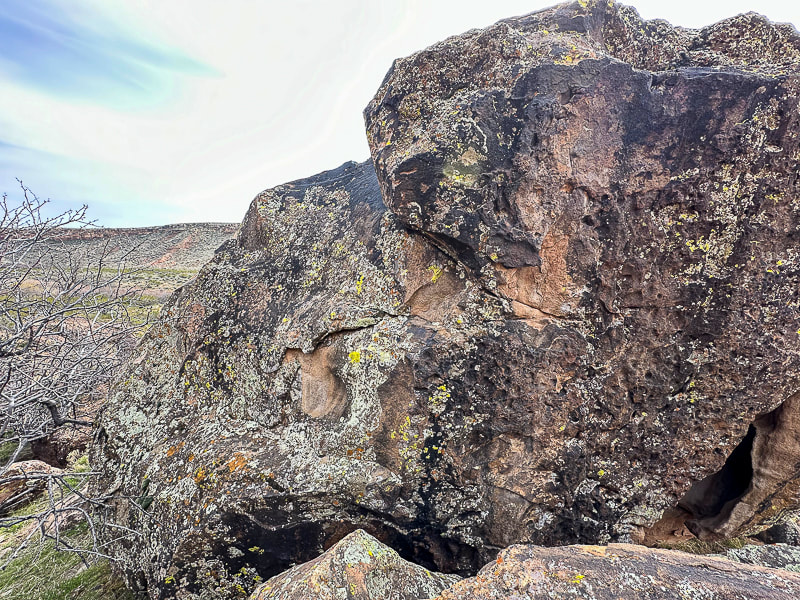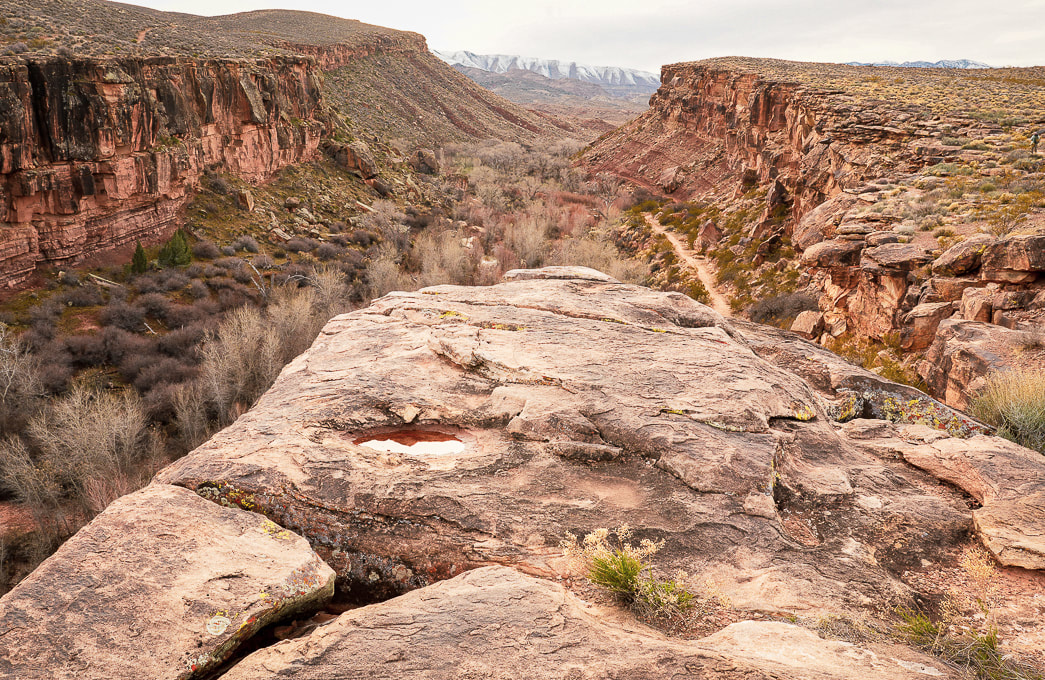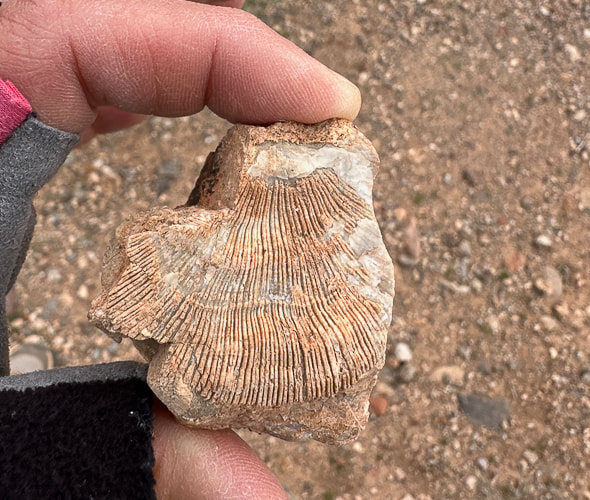|
Unravelling the mysteries of two unique, older petroglyph sites that I found along the Santa Clara River in Utah. Abstract petroglyph overlooking the Santa Clara River in the Santa Clara River Reserve.
This design closely resembles an Ancestral Puebloan (formerly Anasazi) petroglyph found in Arizona. Checkerboard designs are associated with Glen Canyon Style 5 made before 1050 A.D. by Ancestral Puebloans including Basketmaker cuture. Related Posts:
Trip Stats Location: Santa Clara River Reserve near Ivins and Santa Clara, Utah - Land Hill. Trailheads: Anasazi Valley Trailhead (north) and Tukupetsi Trailhead (south). Distance: The distance that includes all of the petroglyphs described here is ~ 5+ miles (top of Land Hill and along the Santa Clara River). Some interesting books: A Field Guide to Rock Art Symbols of the Greater Southwest by Alex Patterson. Early Rock Art of the American West: The Geometric Enigma by Ekkehart Malotki and Ellen Dissanayake. The Rock Art of Utah by Polly Schaafsma Links: Santa Clara River Reserve Map Santa Clara/Land Hill is designated as an Area of Critical Environmental Concern (ACEC). Geology: Petroglyphs are located in the oldest rocks of the Santa Clara Quadrangle Geologic Map: - Shinarump Member Upper Sandstone unit and Shinarump Conglomerate Member of the Chinle Formation: Upper Triassic (~ 200 million years ago). Petroglyphs in sandstone and dinosaur tracks in conglomerate. -Cliffs below Land Hill along the Santa Clara River: Upper Red Member of the Moenkopi Formation: Lower Triassic (~ 250 million years ago). The fascinating rock art on the Tempi'po'op Trail (Anasazi Valley Trail) in Ivins, Utah, made by the Virgin Ancestral Puebloan and Southern Paiute cultures thousands of years ago can be discovered for more than two miles along the cliffs of Land Hill, overlooking the Santa Clara River. Additionally, many more petroglyphs are pecked into huge boulders and sheer walls beneath Land Hill, next to the river. Each time I explore this part of the Santa Clara River Reserve, I find new petroglyphs. On a recent wander, I discovered two intriguing petroglyph sites that I had previously passed by.
Five bighorn sheep on the right side of the boulder along with two large columns made with parallel vertical lines bisected incrementally with horizontal lines are pecked next to the older-appearing, lichen-filled and more highly eroded geometric glyphs. Who made these abstract/geometric petroglyphs and what do they "mean"? Various theories include shamanistic visions, recording of phosphenes, and communication of vital information like water sources. The Paiute word for them, Tumpituxwinap, translates roughly as "storied rocks."
Huge boulder on flat area near Santa Clara River predominated by abstract/geometric petroglyphs, possibly of the Great Basin Curvilinear and Rectilinear style. The right side of the boulder; these deer and sheep petroglyphs seem to be younger than those on the left side because they are not as eroded. The plant-like image (upper left) looks like a corn tassle to me. Petroglyph on top of boulder (left). It reminds me of a necklace: it's similar to those that are pecked into a boulder nearby. It looks like a chain of circles, which might indicate the Great Basin Curvilinear style. In Search of the Rattlesnake Petroglyph. Back of boulder with what I could find as the easiest route to the top.
Phosphenes are lately being proposed by scientists as the catalyst for the creation of abstract designs. All humans experience phosphenes that occur during hyperventilation, migraine headaches, meditation, use of hallucinatory drugs, fatigue and hunger and pressure put on a closed eye. The idea is that geometric petroglyphs and pictographs depict an innate visual grammar (Engel in Fein, 1993) that we all share, ingrained in the biology of our brains. My earlier post Corn Springs Petroglyphs: Vision Quests, Steamboats, and Ringing Rocks explains a few theories for the creation of the Western Archaic Tradition rock art. The Santa Clara Boulder and the "Abstract Enigma" I found two photos of petroglyphs very similar to that of the spoked circle design on the large boulder by the river. One illustrates the Western Virgin Kayenta style and the other illustrates Great Basin Carved Abstract petroglyphs. This spoked circle seems less prevalent than the spiral petroglyphs that appear frequently on the cliffs above the river. Great Basin Abstract tradition rock art spans the Archaic and the Late Prehistoric (8,000-150 years ago). The Great Basin Carved Abstract style occurs in St. George, Utah area. It's characterized by purely geometric petroglyphs that fill boulders so that little unmarked space is left. Art includes various circle configurations, grooves, grids, lattices, herringbone shapes, ladder-like shapes, chevron, hatchmarks and dots. This boulder along the Santa Clara River contains some of these elements. Since this style is found not only in Nevada's Great Basin, but throughout the American West, some scientists call it "Carved Abstract". The rows of vertical lines cut with horizontal lines, surrounded by a line are similar to "gridiron" petroglyphs seen in New Mexico. The parallel wavy lines above the spoked circle are considered Great Basin Curvilinear, which I read is another way to say Great Basin Carved Abstract. The grids and cross-hatchings, and perpendicular form is known as "rectilinear." These styles are associated with the Archaic style and also occur in styles associated with Puebloan and Fremont groups. Two authors state that the Great Basin Abstract petroglyphs appear to be made as a part of "magic hunting ritual and were related to subsistence practices..." (Heizer and Baumhoff). Abstract designs predominate this style, with a limited depiction of animals. The most common animal portrayed is the bighorn sheep. I also noticed what appeared to be cupules (pit and groove style) on the back side of the boulder. Or are these holes just natural weathering? Or both? One pit placed on the side of the boulder looks too symmetrical to be made by weathering. Theories for their creation include fertility enhancement and the use of powder produced from making them. Cupules or natural weathering? Cupules are associated with very early Carved Abstract Style. It's assumed that cupule sites identify places of significance. Anthropomorphic (Human-like) petroglyph on a flat boulder near the Een'oog Trail and the cliffs overlooking the Santa Clara River. Size is ~ 14 inches tall. Is a Snake Biting the Figure with the Drooping Hands? The second amazing petroglyph I found is on top of Land Hill along the Een'oog Trail, on the cliffs above the Santa Clara River. It's totally repatinated, blends into the rock, so it's easily missed (see above). Its drooping arms, termed "pendant" by scientists, round head, hair bobs, long rectangular or slightly trapezoidal (wider at the shoulders), and feet and hands pointing down match the description I found of the Anasazi Basketmaker culture - 500 BC - 800 AD. The term "Anasazi" has now been replaced by "Ancestral Puebloan." A serpentine-like line winds its way from the left side of the figure to the figure's leg. These “representational” styles are typically associated with Fremont and Western Puebloan cultures (ca. 2,000-750 years ago) in southeastern Nevada, Utah, and the Colorado Plateau. These semi-horticultural groups made rock art that featured human-like forms portrayed by trapezoidal, rectangular, or triangular body shapes. These were often portrayed with bodily decoration such as headgear, jewelry, or decorated clothing. In my research, I found the Classic Vernal-Style (a sub-set of Fremont Style) Anthropomorph has large heads and trapezoidal torsos with well-defined extremities. The Fremont style tends to have round earbobs and arms and hands held down, commonly with splayed fingers. In western Utah, there is an intermix of Great Basin Curvilinear and Fremont styles. Ancestral Puebloan farmers lived in the Land Hill area in permanent settlements ~ 1,000 years ago. The Santa Clara River gave them a good water supply to irrigate their crops. During A.D. 700 - 1100, population on Land Hill thrived, but then around 1200 A.D., population decreased possibly due to changing climatic conditions. I found an old corn cob in a grassy area beneath the cliffs next to the river (see photo below). Every kernel had been removed. It couldn't have survived hundreds of years! Or could it have been exhumed after the record-setting rains of 2022-2023 that caused a major landslide at an area close to it? A Land Rich in Culture, Stories, and Mystery Dinosaur tracks have been documented on Land Hill. At first glance, you wouldn't imagine that the Santa Clara River Reserve holds so many stories among its cliffs, plateaus, and rock art. If you look closely, you will see abstract and representational communication made by different cultures during different times. In my quest to figure out who made these fascinating petroglyphs and why, I realize that if anything, they still remain an enigma. I'll let you know if I find the dinosaur tracks and more corn cobs! Keep Exploring! When I went to look at the figure with the round head and the ear bobs again (lower right), I shared the petroglyph rock with a goose. Petroglyphs (walls on right) overlooking the Santa Clara River. Land Hill on the right and a path that runs along the Santa Clara River. Beaver Dam Mountains in the distance. Petroglyphs are found on the flat surface rocks, in the steep cliffs of Land Hill, and on boulders along the river. Finding a route down from the top of Land Hill with my friend Laura. We are headed to the Santa Clara River below. Notice the Shinarump conglomerate rock in the right foreground. When we got near the river, we found this boulder with what looks like Great Basin Curvilinear style and a family of anthropomorphs (human-like) figures. Petroglyphs on the Anasazi Valley Trail in Ivins, Utah. The Glen Canyon Style 5 (Ethnic groups are Early Puebloan and Basketmaker). Bighorn sheep have large rectangular bodies disproportionately large compared to their small heads, tail and legs. Laura and some really cool sandstone boulders along the Santa Clara River. Some Cool Stuff on the Trail Clockwise from upper left: slickensides created from scraping against other rocks in a fault, bivalve fossil near the Een'oog Trail, a corn cob, a desert-varnished panel on an eroded sandstone boulder. Sandstone boulder detail. References Bureau of Land Management. Land Hill Heritage Site. Malotki, Ekkehart. The Rock Art of Arizona: Art for LIfe's Sake. From website: Bradshaw Foundation. Mangum, M.E. 2018. Lithics and Mobility at Land Hill and Hidden Hills: A Study of the Stone Tools and Debitage at Sites in the Santa Clara River Basin and on the Shivwits Plateau. Brigham Young University ProQuest Dissertations Publishing, 2018. 28107515. National Park Service. Reading Rock Markings. Schaafsma, P. 1971. The Rock Art of Utah. Scotter, T. Bowen , N. 2017. The Rock Art of Utah. The Nevada Rock Art Foundation - Styles and Themes Willis, J.C., Hayden, J.M. 2015. Geologic Map of the Santa Clara Quadrangle, Washington County, Utah.
6 Comments
3/26/2024 08:26:27 am
Absolutely fascinating stuff. Trying to decode ancient art language is complicated and imprecise because there is no one to step forward with first-hand knowledge to correct or suggest new or different interpretations. We can guess and infer certain interpretations, but really, just sitting with these ancient remains of those who walked the land before, frees the mind to wonder and imagine. What was it like for the one who created these images? What did they look like? How did they survive the perils of life in the open? What were their family units like? What were their daily dramas?
Reply
Linda,
Reply
Laura Fox
3/27/2024 10:29:20 pm
Sue,
Reply
Ha, Laura!! We never found out the sex of the goose - I guess it didn't like when I turned the You Tube video explaining the topic, so it flew away. Not only did we not find out, but we missed the company of the goose! There are times when NOT to use technology.
Reply
Laura Fox
3/28/2024 05:54:07 pm
Sue, Leave a Reply. |
Categories
All
About this blogExploration documentaries – "explorumentaries" list trip stats and highlights of each hike or bike ride, often with some interesting history or geology. Years ago, I wrote these for friends and family to let them know what my husband, Fred and I were up to on weekends, and also to showcase the incredible land of the west.
To Subscribe to Explorumentary adventure blog and receive new posts by email:Happy Summer!
About the Author
|











